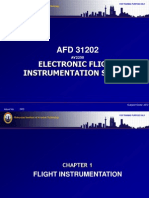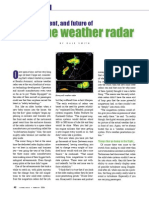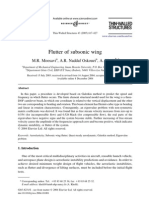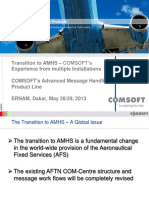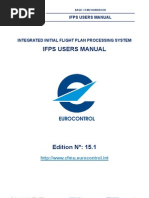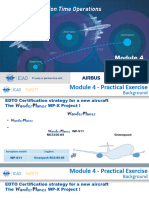RAIM Algorithm Prediction
Uploaded by
FreewindRiderRAIM Algorithm Prediction
Uploaded by
FreewindRiderAPANPIRG/25 IP/16
Agenda Item: 3.4
INTERNATIONAL CIVIL AVIATION ORGANIZATION
TWENTY FIFTH MEETING OF THE
ASIA/PACIFIC AIR NAVIGATION PLANNING AND
IMPLEMENTATION REGIONAL GROUP (APANPIRG/25)
Kuala Lumpur, Malaysia, 8 11 September 2014
Agenda Item 3:
3.4:
Performance Framework for Regional Air Navigation Planning and
Implementation
CNS
PROGRESS ON THE ESTABLISHMENT OF RAIM PREDICTION SYSTEM
(Presented by Thailand)
SUMMARY
This paper presents information on the establishment of a Regional RAIM
(Receiver Autonomous Integrity Monitoring) System. GNSS (Global
Navigation Satellite Systems) is considered a main navigation infrastructure
supporting PBN (Performance Based Navigation) operations. It is now also
becoming a critical component of surveillance systems, such as ADS-B
(Automatic Dependent Surveillance-Broadcast). Unpredicted outage of
GNSS services can cause undesired interruptions on aircraft operations.
ICAO Annex 10 and ICAO PBN manual require States and ANSPs (Air
Navigation Service Providers) to provide timely warnings of GNSS RAIM
outages. RAIM prediction results are needed daily by pilots, flight
dispatchers, air traffic controllers and airspace planners.
Strategic Objectives:
A:
Safety Enhance global civil aviation safety
B:
Air Navigation Capacity and Efficiency Increase the
capacity and improve the efficiency of the global aviation
system
1.
INTRODUCTION
1.1
Implementations of PBN and GNSS facilitate more efficient use of airspace and more
flexibility for operational procedure. They cooperatively result in enhanced safety, access, capacity,
predictability, operational efficiency, fuel economy, and environmental sustainability.
1.2
Implementation of PBN is strongly supported by major aviation stakeholders,
including ICAO, IATA, and CANSO. On 1 April 2009, a joint industry declaration in support of PBN
implementation was issued calling upon all leaders of the civil aviation community to fully support
implementation of PBN into the air navigation system in accordance with the ICAO provisions and
established timetable.
APANPIRG/25 IP/16
-2-
Agenda Item: 3.4
1.3
GNSS is considered the main navigation infrastructure supporting PBN operations.
GNSS provides highly accurate and high-integrity navigation and positioning services for aircraft.
GNSS also enables on-board monitoring and alerting capability which are required for Required
Navigation Performance (RNP) operations.
1.4
Unpredicted outages of GNSS services can cause undesired interruptions on aircraft
operations. Safety impacts may become more severe during approach phase of flights especially if
pilots are not aware of such outages.
1.5
ICAO APANPIRG/20 meeting was reminded that GPS (Global Positioning System)
prediction service was a necessary part of GNSS approvals to allow for the fluctuations in service
availability. Concern was also raised over possible future GNSS outages due to satellite constellation
anomalies and other factors.
1.6
GNSS is presently not only used for navigation, but is also becoming a critical
component of surveillance system, such as ADS-B in addition to many aviation applications that
depend on accurate timing such as SSR Radar.
2.
DISCUSSION
Requirements for Receiver Autonomous Integrity Monitoring (RAIM)
2.1
Receiver Autonomous Integrity Monitoring (RAIM) provides integrity monitoring of
GNSS satellites for aviation applications. RAIM utilizes redundancy of satellite signal measurements
combined with aircraft barometric altitude equipment to detect any faulty satellite signal based on
satellite geometry and probability analysis.
2.2
ICAO Annex 10 and ICAO PBN manual require States and ANSPs to provide timely
warnings of GNSS RAIM outages. A pre-flight GNSS RAIM prediction analysis is required by the
FAA for flights intending to use RNAV/RNP routes as well as departure and arrival procedures while
using GPS as the sole navigation source.
2.3
RAIM prediction results are needed daily by pilots, flight dispatchers, air traffic
controllers and airspace planners. The use of appropriate RAIM prediction services is considered to be
a necessary part of GNSS approvals. Pilots and air traffic controllers need such information to ensure
proper flight planning during possible service unavailability.
2.4
RAIM prediction is required for en-route, terminal area, and approach operations.
RAIM prediction algorithms for different types of GNSS receivers and avionic configuration are also
different.
Regional RAIM Prediction Service
2.5
As RAIM service prediction algorithms use pre-determined satellite orbit and
maintenance schedule to assess future outages, one single RAIM prediction system can technically
provide a RAIM prediction service for the whole world or an entire region.
2.6
However, it is still within States responsibilities to provide RAIM outage
information to airspace users and aviation stakeholders. All safety-related information provided by a
RAIM prediction service will need to be recognized and authorized by State before it can be used.
2.7
With these reasons, it is thus not cost effective for each State to invest on an
individual RAIM prediction system. Moreover, various implementations of RAIM prediction services
may result in inconsistency of RAIM prediction information provided by various States. This may
cause operational problems especially during en-route operation over international airspace.
-3-
APANPIRG/25 IP/16
Agenda Item: 3.4
2.8
A common, regional RAIM prediction service for region such as South-East Asia can
prove to be an effective solution. By harmonizing RAIM prediction information among States, the
regional RAIM prediction service will enhance seamless air traffic operation, while providing a costeffective investment solution. A regional RAIM project will also provide a forum for States to share
their knowledge and experiences.
2.9
ICAO APANPIRG Decisions 20/38 and 20/39 task the ICAO PBN Task Force to
examine the feasibility of establishing a regional RAIM prediction system and invite ICAO to develop
guidance materials on establishing common implementation rules and technical standards for GNSS
reporting and prediction requirements.
2.10
The 46th DGCA Conference encouraged States to support and place priority on the
ICAO Task Forces and work programmes for the Asia-Pacific. Proposals on specific mechanisms,
such as a regional RAIM prediction service, could also be looked into.
Current PBN Manual RAIM Prediction Requirements
2.11
The PBN Manual contains numerous requirements for various forms of GNSS
prediction plus requirements for ANSP providers to monitor the status of GNSS and issue timely
warnings of outages (Paragraph 4.3.1.2). For example, RNP 10 requires FDE (Fault Detection and
Exclusion) availability prediction program must be used (Paragraph 1.3.4.2.1.4). For RNAV En-route
RAIM levels are required and can be verified either through NOTAM (where available) or through
prediction services. The operating authority may provide specific guidance on how to comply with
this requirement (e.g. if sufficient satellites are available, a prediction may not be necessary).
Operators should be familiar with the prediction information available for the intended route
(Paragraph 2.3.4.3.1).
2.12
The following factors influence both status monitoring and RAIM prediction and
these can differ between aircraft:
a) Receiver RAIM algorithms of different receivers;
b) Satellites in view can be a different set;
c) Receiver mask angle can vary; and,
d) Integration with other sensors/aids (DME/DME, baro, inertial) may or may not be
available to the navigation system.
2.13
The current approvals for the use of GPS as a primary means of oceanic and remote
navigation require the operator to have a separate (to the receiver) receiver specific prediction system
that takes into account the requirements of the flight.
Minimal Technical and Operational Requirements for a Regional RAIM Prediction System
2.14
The PBN/TF/7 meeting agreed in principle the establishment of a regional RAIM
prediction system and cooperation between the ICAO PBN TF and the APEC GIT. The PBN/TF also
endorsed the Minimal Technical and Operational Requirements for a Regional RAIM Prediction
System as followings:
2.15
Basic Common Denominator - Noting the differences among different RAIM
algorithms on-board different aircraft, a regional RAIM prediction system provided by a service
provider, such as an ANSP, should provide a basic common denominator RAIM prediction service
for basic GNSS receivers, such TSO-129 (Fault Detection) and TSO-145/146 (Fault Detection and
Exclusion).
APANPIRG/25 IP/16
-4-
Agenda Item: 3.4
2.16
Prediction Period A regional RAIM prediction system shall provide prediction for
RAIM outage and number of GNSS-satellite availability for a 72 hour period using the latest available
GPS NANU.
2.17
Approach Operations - A regional RAIM prediction system shall support aircraft
approach operations based on RNP APCH (with/without Baro-VNAV) navigation specification. The
system shall calculate the predicted RAIM availability for a 72 hour period for specific Aerodromes.
The algorithms shall address the RAIM requirements for GNSS receivers operating in Approach
operations (0.3NM). Both the Fault Detection (FD) and Fault Detection and Exclusion (FDE)
algorithms shall be provided. The system shall calculate the predicted RAIM availability at the
Aerodrome Reference Point (ARP) for baro (pressure altitude) aided and non-baro aided GNSS user
equipment at 1 minute intervals or better.
Progress of the Establishment of RAIM Prediction System
2.18
AEROTHAI has procured and successfully implemented the initial establishment of
the RAIM Prediction System in April 2013. The service is named NETRA which means eyes in
Sanskrit. The system, developed by DW International, utilizes the same engine as EUROCONTOLs
AUGUR GPS RAIM Prediction Tool. The initial operation for Bangkok FIR has been commenced
since October 2013. The current operation features a web-based service that can be accessed via the
Internet at www.netra.aero. The RAIM Outage Prediction NOTAM generation capability is expected
to be added by the end of 2014. The system can be expandable to provide RAIM prediction services
for any other interested participating States within the Asia/Pacific Region at minimal costs.
3.
3.1
ACTION BY THE MEETING
The Meeting is invited to:
a) note the importance and requirements for RAIM prediction services for GNSS
and PBN operations;
b) note the progress on the establishment of the RAIM Prediction System in
Thailand as presented in this Information Paper; and,
c) note and consider the way forward for cooperative work with States in expanding
RAIM prediction services up to the regional level.
END
You might also like
- Use of Commander's Discretion - EWC OpinionNo ratings yetUse of Commander's Discretion - EWC Opinion7 pages
- Unit Layouts & Room Sizes: Residential Design Element100% (1)Unit Layouts & Room Sizes: Residential Design Element5 pages
- Session22-A-SPICE Compliance Made Easy Case Studies and Lessons Learned100% (1)Session22-A-SPICE Compliance Made Easy Case Studies and Lessons Learned49 pages
- Aircraft Dispatcher Practical Test Standards (2025): FAA-S-8081-10EFrom EverandAircraft Dispatcher Practical Test Standards (2025): FAA-S-8081-10ENo ratings yet
- Welcome To Aeas 419: Aviation Terminology and Glossary100% (1)Welcome To Aeas 419: Aviation Terminology and Glossary29 pages
- Normal Procedures: Airspace: Code7700 (Index - HTM)No ratings yetNormal Procedures: Airspace: Code7700 (Index - HTM)7 pages
- Fot-999-0055-22-00 - Loss of Bleed Air Leak Detection CapabilityNo ratings yetFot-999-0055-22-00 - Loss of Bleed Air Leak Detection Capability4 pages
- Ethics: Case Study: Boeing 737 Max (Information Current As of June 4, 2019)No ratings yetEthics: Case Study: Boeing 737 Max (Information Current As of June 4, 2019)34 pages
- Understanding Required Navigation Performance (RNP) and Area Navigation (RNAV) OperationsNo ratings yetUnderstanding Required Navigation Performance (RNP) and Area Navigation (RNAV) Operations8 pages
- Tool Kit: FSF ALAR Briefing Note 1.3 - Golden RulesNo ratings yetTool Kit: FSF ALAR Briefing Note 1.3 - Golden Rules4 pages
- Required Navigation Performance: The World ofNo ratings yetRequired Navigation Performance: The World of5 pages
- Manual On Volcanic Ash, Radioactive Material and Toxic Chemical Clouds100% (1)Manual On Volcanic Ash, Radioactive Material and Toxic Chemical Clouds159 pages
- Guidelines For Atc Coordination and Transfer of Control Ed-2-0No ratings yetGuidelines For Atc Coordination and Transfer of Control Ed-2-052 pages
- Airport Planning Manual: APM-1901 15 AUGUST 2005No ratings yetAirport Planning Manual: APM-1901 15 AUGUST 2005114 pages
- Module 5: Digital Techniques and Electronic Instrument SystemsNo ratings yetModule 5: Digital Techniques and Electronic Instrument Systems81 pages
- Brochure Safedock A Vdgs and Safecontrol Apron Management CombineSmallNo ratings yetBrochure Safedock A Vdgs and Safecontrol Apron Management CombineSmall16 pages
- Work WWW PDF s7 Q Question-Bank-Human-Factors-Easa-Part-66No ratings yetWork WWW PDF s7 Q Question-Bank-Human-Factors-Easa-Part-663 pages
- Reduced Vertical Separation Minimum (RVSM) Approvals100% (1)Reduced Vertical Separation Minimum (RVSM) Approvals33 pages
- Easa Regulat Struct Diag 2024.02.20 - Incl LinksNo ratings yetEasa Regulat Struct Diag 2024.02.20 - Incl Links1 page
- Aerodynamic: Prepared by Aji Hudallil MTQNo ratings yetAerodynamic: Prepared by Aji Hudallil MTQ26 pages
- Teaching and Testing in Flight Simulation Training Devices (FSTD)No ratings yetTeaching and Testing in Flight Simulation Training Devices (FSTD)32 pages
- Tm-Editor 25.04.2016 Seite 1 010-Air Law - LTM: 3.5.1 Annex 2: Typ: MC 1 Aviaexam22 9/29/2009 PKT.: 1.00No ratings yetTm-Editor 25.04.2016 Seite 1 010-Air Law - LTM: 3.5.1 Annex 2: Typ: MC 1 Aviaexam22 9/29/2009 PKT.: 1.00199 pages
- JCAB English Test and ATC Communications Speech SpeedsNo ratings yetJCAB English Test and ATC Communications Speech Speeds17 pages
- College of Engineering, Nanded: Applications of Aeronautical CommunicationNo ratings yetCollege of Engineering, Nanded: Applications of Aeronautical Communication26 pages
- Chapter 3 - Passenger Compartment Equipment100% (1)Chapter 3 - Passenger Compartment Equipment87 pages
- EDTO Module 4 - Practical - Exercise - SlidesNo ratings yetEDTO Module 4 - Practical - Exercise - Slides19 pages
- Aerodynamics for the Commercial Pilot: Aviation Books Series, #10From EverandAerodynamics for the Commercial Pilot: Aviation Books Series, #10No ratings yet
- Chapter 1 - Differential GPS: RTO-AG-160-V21 1 - 1No ratings yetChapter 1 - Differential GPS: RTO-AG-160-V21 1 - 118 pages
- Practical UML - A Hands-On Introduction For Developers PDFNo ratings yetPractical UML - A Hands-On Introduction For Developers PDF10 pages
- System Analysis and Design: Unit OverviewNo ratings yetSystem Analysis and Design: Unit Overview18 pages
- White Paper Implementing Isa tr880002 PackmlNo ratings yetWhite Paper Implementing Isa tr880002 Packml7 pages
- Optimization For Operation and Information Process of Railway LogisticsNo ratings yetOptimization For Operation and Information Process of Railway Logistics4 pages
- Module 30 Network Vulnerability AssessmentNo ratings yetModule 30 Network Vulnerability Assessment27 pages
- Paradigms of Computer Programming and C++ CST-152 Common To All Branches of First Year First Year, 2nd SemesterNo ratings yetParadigms of Computer Programming and C++ CST-152 Common To All Branches of First Year First Year, 2nd Semester28 pages
- ATR72-AIRCRAFT MAINTENANCE MANUAL - Description/Operation: Printed in FranceNo ratings yetATR72-AIRCRAFT MAINTENANCE MANUAL - Description/Operation: Printed in France125 pages
- F34 Ert: Agricultural Application F34 Tier 4B Series100% (1)F34 Ert: Agricultural Application F34 Tier 4B Series141 pages
- ENCS Security Requirements For Procuring Smart Meters and DCs v2!3!28uJCyGNo ratings yetENCS Security Requirements For Procuring Smart Meters and DCs v2!3!28uJCyG32 pages
- Designing The Modules: Shari L. Pfleeger Joanne M. Atlee 4 EditionNo ratings yetDesigning The Modules: Shari L. Pfleeger Joanne M. Atlee 4 Edition101 pages
- EEE 582 Intelligent Systems - Lecture 3 - MU - 2024 - S2No ratings yetEEE 582 Intelligent Systems - Lecture 3 - MU - 2024 - S218 pages
- Agile Software Development RCS E43 4yr 7sem100% (1)Agile Software Development RCS E43 4yr 7sem83 pages
- Function Safety and Hima Initiation SummaryNo ratings yetFunction Safety and Hima Initiation Summary7 pages
- Unit Layouts & Room Sizes: Residential Design ElementUnit Layouts & Room Sizes: Residential Design Element
- Session22-A-SPICE Compliance Made Easy Case Studies and Lessons LearnedSession22-A-SPICE Compliance Made Easy Case Studies and Lessons Learned
- Aircraft Dispatcher Practical Test Standards (2025): FAA-S-8081-10EFrom EverandAircraft Dispatcher Practical Test Standards (2025): FAA-S-8081-10E
- Welcome To Aeas 419: Aviation Terminology and GlossaryWelcome To Aeas 419: Aviation Terminology and Glossary
- Normal Procedures: Airspace: Code7700 (Index - HTM)Normal Procedures: Airspace: Code7700 (Index - HTM)
- Fot-999-0055-22-00 - Loss of Bleed Air Leak Detection CapabilityFot-999-0055-22-00 - Loss of Bleed Air Leak Detection Capability
- Ethics: Case Study: Boeing 737 Max (Information Current As of June 4, 2019)Ethics: Case Study: Boeing 737 Max (Information Current As of June 4, 2019)
- Understanding Required Navigation Performance (RNP) and Area Navigation (RNAV) OperationsUnderstanding Required Navigation Performance (RNP) and Area Navigation (RNAV) Operations
- Tool Kit: FSF ALAR Briefing Note 1.3 - Golden RulesTool Kit: FSF ALAR Briefing Note 1.3 - Golden Rules
- Manual On Volcanic Ash, Radioactive Material and Toxic Chemical CloudsManual On Volcanic Ash, Radioactive Material and Toxic Chemical Clouds
- Guidelines For Atc Coordination and Transfer of Control Ed-2-0Guidelines For Atc Coordination and Transfer of Control Ed-2-0
- Module 5: Digital Techniques and Electronic Instrument SystemsModule 5: Digital Techniques and Electronic Instrument Systems
- Brochure Safedock A Vdgs and Safecontrol Apron Management CombineSmallBrochure Safedock A Vdgs and Safecontrol Apron Management CombineSmall
- Work WWW PDF s7 Q Question-Bank-Human-Factors-Easa-Part-66Work WWW PDF s7 Q Question-Bank-Human-Factors-Easa-Part-66
- Reduced Vertical Separation Minimum (RVSM) ApprovalsReduced Vertical Separation Minimum (RVSM) Approvals
- Teaching and Testing in Flight Simulation Training Devices (FSTD)Teaching and Testing in Flight Simulation Training Devices (FSTD)
- Tm-Editor 25.04.2016 Seite 1 010-Air Law - LTM: 3.5.1 Annex 2: Typ: MC 1 Aviaexam22 9/29/2009 PKT.: 1.00Tm-Editor 25.04.2016 Seite 1 010-Air Law - LTM: 3.5.1 Annex 2: Typ: MC 1 Aviaexam22 9/29/2009 PKT.: 1.00
- JCAB English Test and ATC Communications Speech SpeedsJCAB English Test and ATC Communications Speech Speeds
- College of Engineering, Nanded: Applications of Aeronautical CommunicationCollege of Engineering, Nanded: Applications of Aeronautical Communication
- Aerodynamics for the Commercial Pilot: Aviation Books Series, #10From EverandAerodynamics for the Commercial Pilot: Aviation Books Series, #10
- Chapter 1 - Differential GPS: RTO-AG-160-V21 1 - 1Chapter 1 - Differential GPS: RTO-AG-160-V21 1 - 1
- Practical UML - A Hands-On Introduction For Developers PDFPractical UML - A Hands-On Introduction For Developers PDF
- Optimization For Operation and Information Process of Railway LogisticsOptimization For Operation and Information Process of Railway Logistics
- Paradigms of Computer Programming and C++ CST-152 Common To All Branches of First Year First Year, 2nd SemesterParadigms of Computer Programming and C++ CST-152 Common To All Branches of First Year First Year, 2nd Semester
- ATR72-AIRCRAFT MAINTENANCE MANUAL - Description/Operation: Printed in FranceATR72-AIRCRAFT MAINTENANCE MANUAL - Description/Operation: Printed in France
- F34 Ert: Agricultural Application F34 Tier 4B SeriesF34 Ert: Agricultural Application F34 Tier 4B Series
- ENCS Security Requirements For Procuring Smart Meters and DCs v2!3!28uJCyGENCS Security Requirements For Procuring Smart Meters and DCs v2!3!28uJCyG
- Designing The Modules: Shari L. Pfleeger Joanne M. Atlee 4 EditionDesigning The Modules: Shari L. Pfleeger Joanne M. Atlee 4 Edition
- EEE 582 Intelligent Systems - Lecture 3 - MU - 2024 - S2EEE 582 Intelligent Systems - Lecture 3 - MU - 2024 - S2

































